工业工程专业英语第三章翻译
工业工程专业英语最全翻译
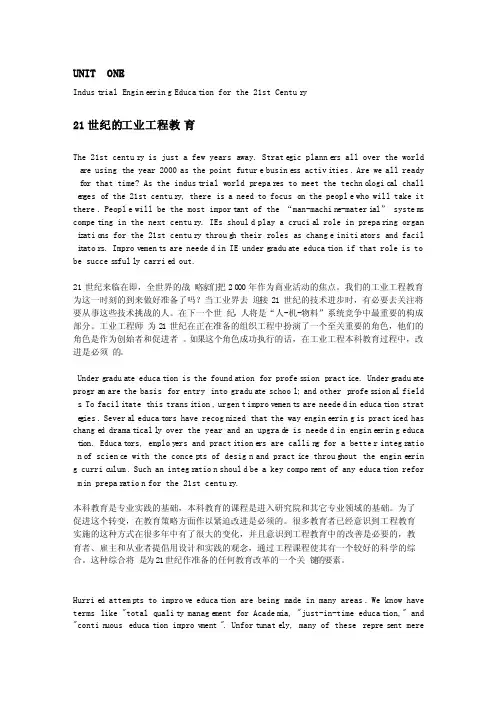
UNIT ONEIndust rialEngine ering Educat ion for the 21st Centur y21世纪的工业工程教育The 21st centur y is just a few yearsaway. Strate gic planne rs all over the world a re usingthe year 2000 as the pointfuture busine ss activi ties.Are we all ready f or that time? As the indust rialworldprepar es to meet the techno logic al chall e n gesof the 21st centur y, thereis a need to focuson the people who will take it there. People will be the most import ant of the “man-machin e-materi al” system s compet ing in the next centur y. IEs should play a crucia l role in prepar ing organ i z atio ns for the 21st centur y throug h theirrolesas change initia torsand facil i t ator s. Improv ement s are needed in IE underg radua te educat ion if that role is to be succes sfull y carrie d out.21世纪来临在即,全世界的战略家们把2000年作为商业活动的焦点。
工业工程专业英语1-3单元翻译
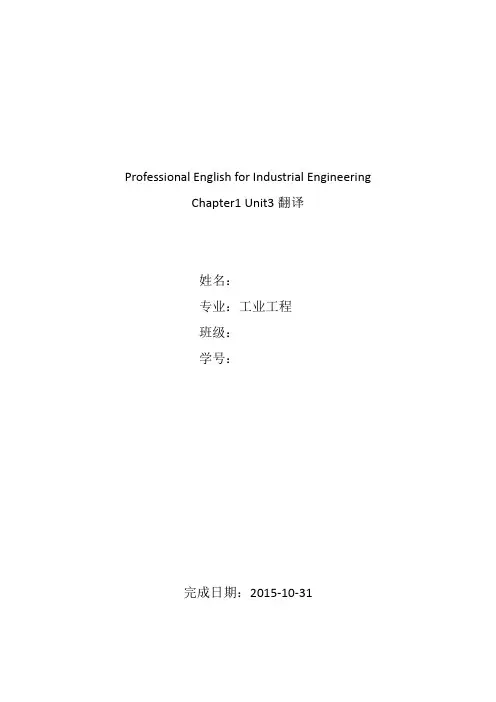
Professional English for Industrial EngineeringChapter1 Unit3翻译姓名:专业:工业工程班级:学号:完成日期:2015-10-31Chapter 1Unit 3 Academic Disciplines of Industrial Engineering五大主要工程学科和它们的发展在美国,有五个主要工程学科(土木、化学、电工、工业、机械),它们是早在第一次世界大战时就出现的工程分支学科。
这些进步是世界范围内发生的工业革命的一部分,并且在技术革命的开始阶段仍在发生。
随着第二次世界大战的发展导致了其他工程学科的发展,比如核工程,电子工程,航空工程,甚至是电脑工程。
太空时代导致了航空工程的发展。
最近对环境的关注使得环境工程和生态工程也得到了发展。
这些更新的工程学科经常被认为是专长学科包含“五大”学科,即土木,化学,电工,工业,和机械工程里的一种或多种。
和美国的情况不同,工业工程在中国属于第一层级管理科学和工程学科下面的第二级别的学科。
IE学科的开端学科后来演变成工业工程学科是最初在机械工程系被作为特殊课程教的。
首个工业工程的分部在1908年的宾夕法尼亚州大学和雪城大学被建立。
(在宾夕法尼亚州的项目是短期存在的,但是它在1925年又重建了)一个在普渡大学的机械工程的IE选科在1911年被建立。
一个更完整的工业工程学院项目的历史可能在资料中被找到。
在机械工程部有一个IE选科的实践是主要的模式直到第二次世界大战的结束,并且分离出来的IE部在整个上个世纪里的文理学院和综合大学里被建立。
早在第二次世界大战的时候,在工业工程方面,只有很少的毕业生水平的研究。
一旦分开的学部建立之后,学士和博士级别的项目开始出现。
现代IE的教育—分支学科今天,与过去相比,工业工程对于不同的人来说意味着不同的东西。
实际上,一个发展一个突出的现代工业工程的方法是通过获得在它的分支学科和它怎么联系到其他领域的理解。
工业工程英语第四到7章全文翻译
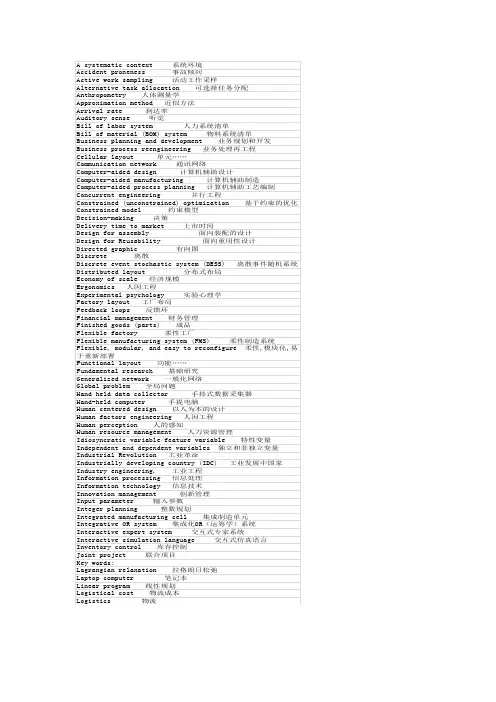
Operations Research 运筹学Some OR accomplishments运筹学的一些成果在 20 世纪 70 年代到 80 年代之间取得了一些十分突出的重大突破,下面讲述他们如何被应用以及其对经济的影响。
Integrative OR systems集成运筹学系统综合的运筹学成果在 1983 和 1984 年,全美最大的石油独立冶炼和销售公司--citgo 石油公司,将 1985 年超过 4 亿的销售额投资在一个独一无二的全面集成系统中,这个系统将运筹学的数学规划、预测及专家系统结合到了统计和组织理论中。
Citgo 将运筹学系统应用到诸如:天然物资的产品开采,冶炼,供应和配送,运作市场规划,应收应付款,存货控制和制定个人执行目标, Citgo 公司由 1984 年 5000 万的营业损失变为到 1985 年高达 7000 万的营业利润要归功于这个运筹学系统。
Network flow problem网络流问题70 年代时出现了一些突破性的网络流建模和解决问题的方法,并初步形成专业化的解决运输问题及其转化问题的原始单纯形算法。
后来广义算法和大型线性网络和嵌入式网络相继出现。
这些算法表现出了前所未有的效率,速度比最好的网络问题通用线性规划系统快了从 10 到 200 倍——效率完全超越任何计算机硬件。
由于现在不可能解决庞大的网络流问题,因此新的应用层出不穷。
目前 Agrico、 Ciba-Geigy、 W.R.Grace、International Paper、Kelly-Springfied、Owens-Corning Fiberglass、Quaker Oats and R.G.Sloan 这些公司已成功地将他们的射频数据采集系统耦合到他们建立的网络流模型上,以改善所做的决定的物流成本效益和服务效益。
比如,Agrico 净减少13%周转资金并在 5 年内节省开支43 万美元;据Kelly-Springfied 报道,他们每年可节省 800 万美元以上,Cahil May Roberts 可减少 20%的运输成本和交货。
工业工程专业英语翻译(3)

什么问题可能会在如此明亮的机会阵列上投下阴影呢?对于初学者来说,随着工业工程新的机遇的产生,诸如工业工程师到底能胜任什么样的工作问题也随之产生。
At one time, it was easier to define what an IE did .” Industrial engineering was simple in those days when we dealt with methods, work standards and work simplification,” says Carlos Cherubin, director of engineering for The Limited Co. “But there has to be some way to get past the old industrial engineering definition.”
值得一提的是,工业工程现在有更多的机会去集中于现在许多企业已经视为独立的学科的众多领域中的一个-----包括防真学、运筹学、人因学、物料搬运和物流学。
The name game
命名问题
What problems could possibly throw a shadow on such a bright array of opportunities? For starters, as new opportunities have developed for the IE, new questions have formed about what types of jobs the industrial engineer is qualified to perform.
工业工程师非常善于解决问题。可是具有讽刺性的却是他们仍有一个长期性的问题得不到解决----一致性。而且这个问题解决起来一直很困难。事实上,“一致性”恰好是目前工业工程领域所面临的众多挑战性问题之一。
工业工程专业英语
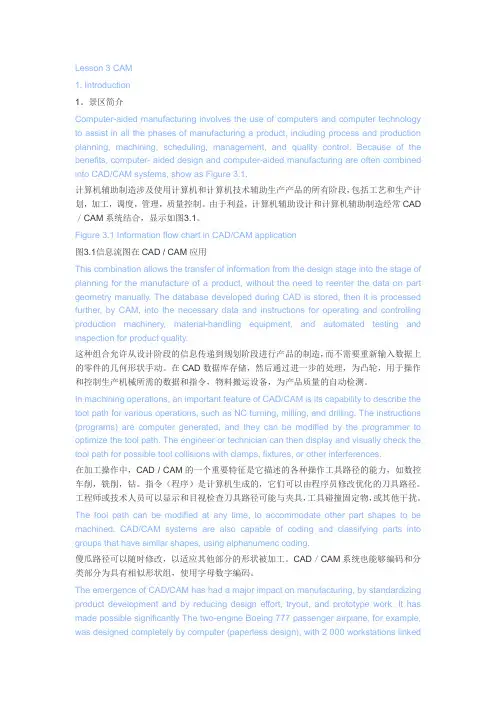
Lesson 3 CAM1. Introduction1。
景区简介Computer-aided manufacturing involves the use of computers and computer technology to assist in all the phases of manufacturing a product, including process and production planning, machining, scheduling, management, and quality control. Because of the benefits, computer- aided design and computer-aided manufacturing are often combined into CAD/CAM systems, show as Figure 3.1.计算机辅助制造涉及使用计算机和计算机技术辅助生产产品的所有阶段,包括工艺和生产计划,加工,调度,管理,质量控制。
由于利益,计算机辅助设计和计算机辅助制造经常CAD /CAM系统结合,显示如图3.1。
Figure 3.1 Information flow chart in CAD/CAM application图3.1信息流图在CAD / CAM应用This combination allows the transfer of information from the design stage into the stage of planning for the manufacture of a product, without the need to reenter the data on part geometry manually. The database developed during CAD is stored, then it is processed further, by CAM, into the necessary data and instructions for operating and controlling production machinery, material-handling equipment, and automated testing and inspection for product quality.这种组合允许从设计阶段的信息传递到规划阶段进行产品的制造,而不需要重新输入数据上的零件的几何形状手动。
工业工程专业英语chapter3manufacturingsystem.ppt
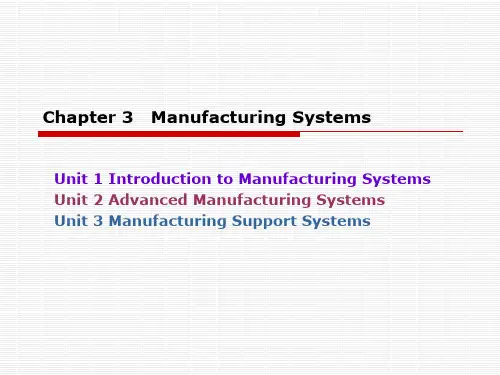
Definition of Manufacturing System
We define a manufacturing system to be a collection of integrated equipment and human resources, whose function is to perform one or more processing and/or assembly operations onl, part, or set of parts.
Chapter 3 Manufacturing Systems
Unit 1 Introduction to Manufacturing Systems Unit 2 Advanced Manufacturing Systems Unit 3 Manufacturing Support Systems
Definition of Manufacturing System
The integrated equipment includes production machines and tools, material handling and work positioning devices, and computer systems.
教学要求:
了解制造系统的含义,制造系统的各个组成部分 掌握几种典型的制造系统集成组技术、柔性制造系统、敏捷制造 等先进制造系统各自应用范围及特点。
了解CAD,CAM,CAPP等辅助制造系统在各种制造系统中的 应用。
本章共两次作业(作业5,作业6)
本章专业词汇
automation:自动化 material handling :物料搬运 synthesize:综合 integrated equipment:集成设备 raw material:原材料 positioning device:定位装置 semi-automatic:半自动化 full automated:全自动化 family:簇 production line:生产线 fixture:固定设备、夹具 hardware:硬件 machine tool:机床 lathe:车床 milling machine:铣床 drill press:钻床 workstation:工作站 portable powered tool:便携式电动工具 assembly line:装配线 machine cell:机器单元 discrete:离散的 ancillary:辅助的、附属的 work unit:工件 mechanized:机械化的 pallet:托盘 tote bin:搬运箱 vicinity:邻近 workhead:工作台、机台 workholder:工件夹具 orient:定向 clamp:夹住 chuck:卡盘
工业工程专业英语课文翻译3
工程2班1202231069袁威武Understanding socio-economic and policy constraints to dairy development in Ethiopia: A coupled functional-structural innovation systems analysisAbstact:This study investigates how the Ethiopian dairy innovation system has functioned to support the development of the Ethiopian dairy sector and what have been the major technical, economic, and institutional constraints in the process. We used a coupled functional–structural analysis of innovation systems to analyse the influence of socio-economic and policy constraints on the development of the Ethiopian dairy sector. Results show that problems with structural elements such as the absence of key actors, limited capacity of existing actors, insecure property rights, cumbersome bureaucratic processes, poor interaction among actors and inadequate infrastructure have all limited dairy innovation. Out of the seven innovation system functions studied, our findings show that entrepreneurship, knowledge diffusion, market development and legitimacy creation have been particularly weak. Our evidence thus suggests that problems with certain structural elements coupled with weaknesses in various innovation system functions have been major hindrances to the uptake of technologies and dairy sector development in Ethiopia. The narrow policy focus on biophysical technology generation and dissemination, without considering the underlying problems related to institutional conditions and socio-economic processes, has also contributed to low technology adoption and limited broader development in the dairy sector. We suggest that combinations of institutional and technological interventions are needed to overcome the various system weaknesses that have hindered dairy sector development in Ethiopia.翻译:本研究探讨如何在多人的乳制品中创新新的系统功能,及在经济和体制约束的过程中支持发展黑人乳制品部门和主要的技术。
工业工程专业英语Chapter 3 Manufacturing System
Human Resources
Human perform some or all of the value-added work that is accomplished on the parts or products.
Classificat5: 2. 课外翻译(把下列语句翻译成中文)
① Flexible manufacturing systems (FMS) and computer /communication networks exemplify complex systems that fall into a class called discrete event stochastic systems (DESS). The efficient design and operation of these systems is extremely important to economic competitiveness, yet system behavior is not completely understood. Present methods of analysis and design of DESS focus on their behavior in the steady state, a conceptualization that requires performance measures to be made “in the long run” or “averaged over time.” Yet,
Unit 1 Introduction to Manufacturing Systems
The Definition of Manufacturing System Components of Manufacturing System Classifications of Manufacturing Systems
工业工程专业英语翻译1
The Roles of IE(p1)工业工程作为一种集经典与新颖于一身的专业出现,在科学技术高速发展的今天,用来解决复杂,系统性的问题。
尤其是经济快速发展并逐步成为世界制造中心的中国,对工业工程的迫切需求将持续增长和扩宽。
一个生产或服务系统包括输入,转换和输出。
通过这种转换,系统的附加值、系统的效率和有效性将得以增长和提高。
转换过程依赖使用的技术和管理科学,有时依赖它们二者。
管理一个生产或一个服务系统是困难和复杂的,它需要基础科学,工程科学,行为科学,电脑和信息科学,经济学方面的知识以及大量与生产及服务系统相关的基本原则与技术。
The Demand for IE Graduates学习工业工程的课程旨在让学生有能力应对发展中国经济和建设和谐社会的挑战。
确实,有很多工业工程的毕业生未来将要规划,运营现代生产系统和工厂。
其他的一些毕业生会选择在类似健康护理,金融,后勤,交通,教育,公共事业管理或者咨询机构工作。
社会对工业工程毕业生的需求是强烈的,并且,这种需求每年还在不断增长。
事实上,工业工程专业的人才是供不应求的。
这种供求不平衡明显高于其他工程和科学领域,并且,在未来很多年里会一直存在。
因此,在2006年,中国有超过165所大学或学院开设了工业工程。
Engineering and Science工业,工程,这两个词是如何结合而构成工业工程这个术语的呢?工业工程和其他工程学科以及工商管理和社会科学有什么关系呢?为了明白工业工程在以经济与知识为基础的现如今的作用,学习IE演变过程中的那些有希望的历史发展是十分有益的。
我们有很多讲述工业工程历史发展的方法,但因为我们的兴趣只是回顾工程发展中的重要事件,尤其是那些IE专业化的因素,所以本单元的讨论较简洁。
更加完整的IE发展史可在参考资料中查到。
一直以来,工程与科学就在一个平行,互补的模式中发展,尽管发展速度不尽一致。
但是,科学是对基本知识的探索,工程是应用科学以解决问题和谋求更好的生活。
精选工业工程专业英语
Understanding the definition of IE(1)
Industrial: any organization integrated systems: a factory, a cityspecialized knowledge: mechanical, physical, and social sciences, the principles and methods of engineering analysis Objectives: to specify, predict, and evaluate, the results to be obtained from such systems
industrial engineering:工业工程manufacturing industry:制造业production system:生产系统service system:服务系统efficiency:效率effectiveness:效果curricula: 课程 (or curriculum)harmonious society:和谐社会IE graduates:工业工程毕业生(IEs)IE engineers:工业工程师(IEs)facility:设备、设施health-care delivery: 卫生保健服务discipline:学科methodology:方法literature:文献economic and knowledge-based era:知识经济时代specialty:专业feedback:反馈hand in hand :合作inclined plane:斜面corkscrew: 螺丝刀simple lever:单杠杆friction: 摩擦molecular:分子的electricity: 电、电学、电流、电气thermal process:热处理manipulate:处理,使用,操纵variable:变量Pythagorean theorem:勾股定理
- 1、下载文档前请自行甄别文档内容的完整性,平台不提供额外的编辑、内容补充、找答案等附加服务。
- 2、"仅部分预览"的文档,不可在线预览部分如存在完整性等问题,可反馈申请退款(可完整预览的文档不适用该条件!)。
- 3、如文档侵犯您的权益,请联系客服反馈,我们会尽快为您处理(人工客服工作时间:9:00-18:30)。
《专业英语》课程论文(工业工程11级)指导教师:李发权小组成员姓名:学号:刘凯311102020215 刘雪涛311102020216 马文杰311102020217 乔茂康3111020202182014年11月23日Manufacturing SystemsUnit1 Introduction To Manufacturing SystemsIn this chapter, we consider how automation and material handing technologies are synthesized create manufacturing systems. We define a manufacturing system to be a collection of integrated equipment and human resources, whose function is perform one or more processing and/or assembly operations on a starting raw material part, or set parts. The integrated equipment includes production machines and tools, material handling and work positioning devices, and computer systems. Human resources are required either full time or periodically to keep the system running. The manufacturing system is where the value-added work is accomplished on the part or product. The position of the manufacturing system in the larger production system is shown as Figure. 3.1 Examples of manufacturing systems include :●One worker tending one machine, which operates on semi-automatic cycle● A cluster of semi-automated assembly machine, attended by one worker● A full automated assembly machine, periodically attended by a human worker● A group of automated machines working on automatic cycles to produce a family ofsimilar parts● A team of workers performing assembly operations on a production lineComponents of a Manufacturing systemA manufacturing system consists of several components. In a given system, these components usually include:1)production machines plus tools, fixtures, and other related hardware;2)material handling system ;3)computer systems to coordinate and/or control the above components ;4)human workersProduction MachinesIn virtually all modern manufacturing systems, most of the actual processing or assembly work is accomplished by machines or with the aid of tools. The machines can be classified as 1) manually operate , 2) semi-automated ,or 3)fully automated , Manually operated machines are directed or supervised by a human worker. The machine provides the power for the operation and the worker provides the control. Conventional machine tools (e. g ,lathes , milling machines ,drill presses ) fit into this category . The worker must be at the machine continuously.In manufacturing systems, we use the term workstation to refer to a location in the factory where some well-defined task operation is accomplished by an automated machine , a worker-and-machine combination , or a worker use hang tools/or portable powered tools. In the last there no definable production machine at the location . Many assembly tasks are in the category . A given manufacturing system may consist of one or more workstations. A system with multiple stations is called a production line , or assembly line , or machine cell ,or other name ,depending on its configuration and function .Material Transport SystemsIn most processing and assembly operations performed on discrete parts and products, the following ancillary functions must be provided :1)loading and unloading work units and2)positioning the work units at each station . In manufacturing systems composed of multipleworkstations, a means of3)transporting work units between stations is also required. These functions are accomplishedby the material handling system . In many case , the units are moved by the workers themselves, but more often some form of automated material transport system is used to reduce human effort .Most material handling systems used in production also provide4) a temporary storage function .The purpose of storage in these is usually to make sure thatwok is always present for the storage , that is, that the stations are not starved (meaning that they have nothing to work on )Some of the issues related to the material handling system are often unique to the particular type of manufacturing system ,and so it makes sense to discuss the details of each discussion here is concerned with general issues relating to the material handling system.Loading, Positioning, and Unloading. These material handling functions occur each workstation. Loading involves moving the work units into the production machine or processing equipment form a source inside the station. For example, starting parts in batch processing operations are often stored in contain in the immediately vicinity of station. For most processing operation, especially those requiring accuracy and precision, the work unit must be positioned in the production machine. Positioning provides for the part to be known location and orientation relative to the work head or tooling that performs the operation.Position in the production equipment is often accomplished using a workholder. A workholder is a device that accurately locates, orients, and clamps the part for the operation and resists any forces that may occur during processing. Common workholder include jigs, fixtures, and chucks. When the production operation has been completed, the work unit must be unloaded, that is, removed form the production machine and either placed in a container at the workstation or prepared for transport to the next workstation in the processing sequence. Prepared for transport may consist of simply loading the part onto a conveyor leading to the next station.When the production machine is manually operated or semi-automatic, loading position, and unloading are performed by the worker either by hand or with the aid of a hoist. A mechanized device such as an industrial robot, parts feeder, coil feeder (in sheet metal stamping ), or automatic pallet changer is used to accomplish these material handling functions.Work Transport Between Station. In the context of manufacturing system, work transport means moving parts between workstation in a multi-station system. The transport function can be accomplished manually or by the most appropriate material transport equipment.In some manufacturing systems, work units are passed from station to station by hand. Manual work transport can be accomplished by moving the units the one at a time or in batches. Moving parts in batches is generally more efficient, according to the unit load principle. Manual work transport is limited to cases in which the parts are small and light, so that the manual labor is ergonomically acceptable. When the load to be moved exceeds certain weight standards, powered hoists and similar lift equipment are used. Manufacturing systems that utilize manualwork transport include manual assembly lines and group technology machine cells.Various types of mechanized and automated material handling equipment are widely used to transport work units in manufacturing systems. We distinguish two general categories of work transport, according to the type of routing between station:1)variable routing and2)fixed routing. In variable routing transport is associated with job shop production andmany batch production operations. Manufacturing systems that use variable routinginclude group technology machine cells and flexible manufacturing systems. In fixedtouting, the work units always flow through the same sequence of station. This meansthat the work units are identical or similar enough that the processing sequence isidentical. Fixed routing transport is used on production lines. The difference betweenvariable and fixed routing and fixed routing is portrayed in Figure 3.2.制造系统制造系统的介绍在这一章,我们考虑如何合成创造制造业自动化和材料处理技术系统。
